The 1996 Mount Everest disaster, occurring on May 10-11, resulted in eight deaths due to a blizzard during their descent from the summit. The tragedy contributed to a total of 12 fatalities during the 1996 climbing season, marking it as the deadliest on Everest until then. It was later surpassed by the 16 deaths in the 2014 avalanche and the 22 fatalities in 2015 due to avalanches triggered by the Nepal earthquake. The incident garnered significant attention and sparked debates about the commercialization of Everest climbs.
The 1996 Everest Disaster became a cautionary tale, about death on Everest and the fragile balance between human ambition and the untamable power of nature.
We look at the events during May 10-11 1996, examining the accounts of the events that day from the climbers, including Jon Krakauer, Anatoli Boukreev, Lou Kasischke, and Ed Viesturs’. I also discuss my opinion of the 1996 Disaster on Mount Everest
Quick Facts – 1996 Everest Disaster:
- Date: May 10-11, 1996.
- Fatalities: Eight climbers lost their lives during the disaster.
- Severe weather conditions, including a sudden blizzard, contributed to the tragedy.
- Renowned mountaineer and expedition leader Rob Hall, who was with Adventure Consultants, died on the mountain.
- Scott Fischer, leader of the Mountain Madness team, also lost his life during the expedition.
- Beck Weathers and Makalu Gau were two climbers who miraculously survived despite being left for dead
- Author Jon Krakauer, a journalist on the Adventure Consultants team, wrote a bestselling book titled “Into Thin Air” about the disaster.
- A risky and challenging rescue operation was conducted to save climbers stranded at high altitudes. Including at the time, the highest helicopter rescue ever
Overview of The 1996 Everest Disaster
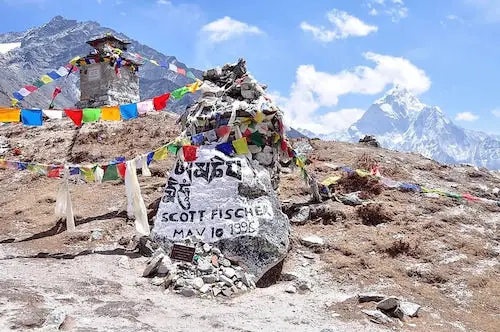
On May 10, 1996 a severe blizzard engulfed Everest, causing the death of eight climbers who were returning from the summit. During the 1996 climbing season, a total of 12 people lost their lives in their attempt to reach the top.
Among the climbers affected by the storm were two teams: Adventure Consultants, led by Rob Hall, and Mountain Madness, led by Scott Fischer. The South Col route, taken by the Adventure Consultants team, saw more casualties and was widely reported. Tragically, four members of the Adventure Consultants team, including Rob Hall, didn’t survive, while Scott Fischer was the only casualty from the Mountain Madness team.
Setting the Stage for Disaster:
During the mid-1990s, Mount Everest witnessed a significant increase in expedition attempts. Factors contributing to this surge included enhanced access to relevant information, advancements in climbing gear and technology, and a growing appetite for adventure among low-skilled enthusiasts. This period saw a varied mix of climbers, ranging from experienced mountaineers to adventurous novices aiming for their first ascent. The mix of experience levels added an extra layer of complexity to the already daunting task of conquering Everest.
The increasing number of climbers, coupled with the limited weather windows for a successful summit, created a crowded and competitive environment on the mountain. it intensified the pressure to reach the summit within a narrow time frame, leading to critical decision-making challenges. All which would compound the deadly environment found in the “death zone” or “rainbow valley” A location above 8,000 meters (26,247 feet) where oxygen levels are dangerously low and many of the climbers would eventually die in 1996.
Climbers on Mount Everest – May 10, 1996
Here is a list of climbers who were making their way towards the summit of Mount Everest on May 10, 1996, using the South Col and Southeast Ridge route. The climbers are grouped according to their expedition and role. Please note that the ages mentioned are based on the year 1996.
1. Adventure Consultants
In 1996, Rob Hall led the Adventure Consultants‘ expedition on Everest, which comprised a group of 19 individuals, including eight clients.
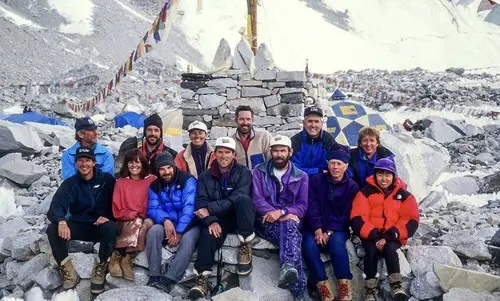
Guides
- Rob Hall (35): Expedition leader; died close to the South Summit
- Mike Groom (37): Survived the disaster
- Andy Harris (31): Disappeared near the South Summit while assisting Hall
Clients
- Frank Fischbeck (53): Survived the disaster, before the 1996 Everest Expedition he had attempted Everest three times and reached the South Summit in 1994
- Doug Hansen (46): He had previously attempted Everest with Hall’s team in 1995. Disappeared near the South Summit while descending with Hall, never to be seen again.
- Stuart Hutchison (34): He was the youngest client on Hall’s team and survived the disaster. His previous climbing experience included K2 winter expedition in 1988, Broad Peak west ridge in 1992, and Everest north side in 1994.
- Lou Kasischke (53): Survived the disaster. He had climbed six of the Seven Summits.
- Jon Krakauer (42): Survived the disaster. He was on an assignment from Outside magazine as a Journalist; an accomplished technical climber, but had no experience in climbing peaks over 8,000 m.
- Yasuko Namba (47): She had climbed six of the Seven Summits, became the oldest woman to summit Everest at the time, and died on the South Col during her descent.
- John Taske (56): The oldest climber on the Adventure Consultants team; no 8,000 m experience. Survived the disaster.
- Beck Weathers (49): He had been climbing for 10 years and was also making a bid for the Seven Summits, but had no 8,000 m experience. Survived the disaster, but had severe frost bite, resulting in the loss of fingers and toes.
Among Rob Hall’s clients, only Namba had previous experience reaching the summit of an 8,000-meter peak. The rest of the clients, except for Fischbeck, Hansen, and Hutchison, had limited or no prior high-altitude Himalayan experience. It’s worth noting that Hall had struck a deal with Outside magazine, offering them advertising space in exchange for a story on the growing popularity of commercial expeditions to Everest.
Originally, Jon Krakauer was supposed to climb with Scott Fischer’s Mountain Madness team. However, Hall managed to secure Krakauer for his own team by agreeing to reduce Outside’s fee for Krakauer’s spot on the expedition to below cost. As a result, Hall was personally funding Krakauer’s presence on his team.
Adventure Consultant Sherpas
- Sardar Ang Dorje (26)
- Arita
- Chuldum
- Kami
- Lhakpa Chhiri
- Ngawang Norbu
- Tenzing
- Lopsang
There were many other Sherpas working at lower elevations who played crucial roles in supporting both the Adventure Consultants and Mountain Madness expeditions. While most climbing Sherpas ascend to at least Camp III or IV, not all of them aim to reach the summit. The expedition leaders typically choose only a select few of their climbing Sherpas to make the summit push.
One notable absence from the Adventure Consultants group was the legendary Sidhar Apa Sherpa, who had initially planned to join but withdrew due to family commitments.
2. Mountain Madness
The Mountain Madness 1996 Everest expedition, under the leadership of Scott Fischer, consisted of a group of 19 climbers, including 8 clients.
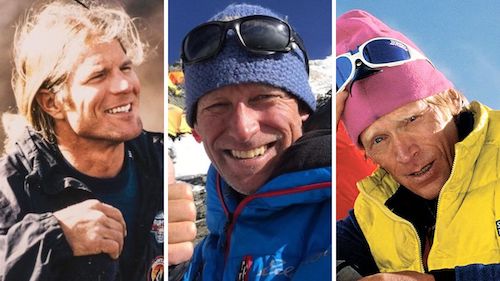
Guides
- Scott Fischer (40): Lead climbing guide; tragically lost his life in the 1996 Everest disaster on the Southeast ridge balcony, approximately 350 meters (1,150 feet) below the South Summit.
- Neal Beidleman (36): Professional outdoorsman.
- Anatoli Boukreev (38): Professional mountaineer and recipient of the David A. Sowles Memorial Award from the American Alpine Club in 1997.
Clients
- Martin Adams (47): Had previous climbing experience on Aconcagua, Denali, and Kilimanjaro.
- Charlotte Fox (38): Accomplished climber who had conquered all 53 of Colorado’s 14,000-foot peaks, as well as Gasherbrum II and Cho Oyu, two 8,000-meter peaks.
- Lene Gammelgaard (35)
- Dale Kruse (45): Fischer’s close personal friend and the first to join the 1996 expedition.
- Tim Madsen (33): Extensively climbed in the Colorado and Canadian Rockies but had no prior experience on an 8,000-meter peak.
- Sandy Hill Pittman (41): Had successfully climbed six of the Seven Summits.
- Pete Schoening (68): Renowned for his solo effort in saving the lives of six team members during a mass fall in the American expedition on K2 in 1953. He was among the first climbers to ascend Gasherbrum I and Mount Vinson.
- Klev Schoening (38): Pete’s nephew and former US national downhill ski racer, but lacked experience on an 8,000-meter peak.
While stationed at Base Camp (5,380 meters or 17,650 feet), Pete Schoening made the decision not to proceed with the final ascent to the summit. On May 6, the team commenced their summit assault, skipping Camp I (5,944 meters or 19,501 feet) and resting for two nights at Camp II (6,500 meters or 21,300 feet).
Unfortunately, Dale Kruse experienced symptoms of altitude sickness, possibly including high-altitude cerebral edema (HACE), and had to remain at Camp I. In response, Scott Fischer descended from Camp II and accompanied Kruse back to Base Camp to receive necessary treatment.
Mountain Madness Sherpas
- Sardar Lopsang Jangbu Sherpa
- “Big” Pemba
- Nawang Dorje
- Ngawang Sya Kya
- Ngawang Tendi
- Ngawang Topche (Sadly, a few months later, he passed away from High Altitude Pulmonary Edema (HAPE) that he developed while performing hauling duties to Camp II)
- Tashi Tshering
- Tendi C.
The Indo-Tibetan Border Police Climbing Group
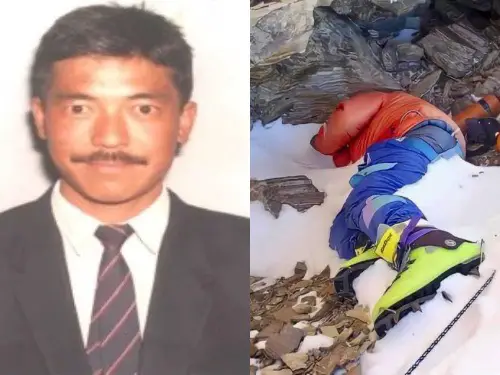
Three members of the Indo-Tibetan Border Police North Col expedition from India, namely Subedar Tsewang Samanla, Lance Naik Dorje Morup, and Head Constable Tsewang Paljor (the famous Green Boots), also lost their lives on the Northeast Ridge in 1996.
The 1996 Mount Everest Disaster Timeline
Let’s explore the important events and choices that influenced the 1996 Mount Everest Disaster, that gave rise to three of the most famous dead bodies on Mount Everest.
Delays Reaching The Summit:
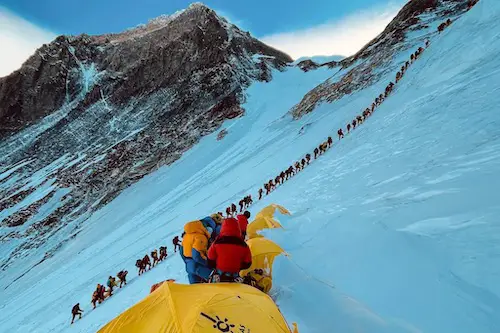
On May 10, 1996, the Adventure Consultants expedition and climbers from Scott Fischer’s Mountain Madness group set off for the summit from Camp IV, located at the South Col (7,900 m). However, they faced several setbacks during their ascent. The Sherpas and guides hadn’t installed the fixed ropes when the climbers reached the Balcony (8,350 m), causing a delay of almost an hour.
At the Hillary Step (8,760 m), another obstacle awaited the climbers. Once again there were no fixed ropes in place, causing the group to have to wait for an hour while the guides installed them. Since around 33 climbers were attempting the summit on the same day and were advised by Hall and Fischer to stay within 150 meters (500 feet) of each other, a congestion occurred at the single fixed line on the Hillary Step. Due to the delays and concerns about running out of supplementary oxygen, climbers Hutchison, Kasischke, and Taske decided to turn back towards Camp IV.
Anatoli Boukreev, a guide from the Mountain Madness team, was the first to reach the summit at 13:07 pm, without using extra oxygen. However, by 14:00, many climbers had yet to reach the summit, which is considered to be the last safe time for them to turn around and return to Camp IV before nightfall.
Boukreev started his descent to Camp IV at 14:30, after spending about 1.5 hours assisting others in completing their climb near or at the summit. By that time, Rob Hall, Jon Krakauer, Andy Harris, Neal Beidleman, Yasuko Namba, and clients Martin Adams and Klev Schoening from the Mountain Madness team had reached the summit, along with the remaining four clients. After this point, Krakauer noticed that the weather was no longer favorable. At 15:00, snowfall began, and the daylight started fading.
Hall’s Sirdar (head Sherpa), Ang Dorje Sherpa, and other climbing Sherpas waited at the summit for the clients. Around 15:00, while they were descending, Ang Dorje encountered client Doug Hansen above the Hillary Step and instructed him to go down. Hansen didn’t respond verbally but shook his head and pointed towards the summit. When Hall arrived, the Sherpas offered to guide Hansen to the summit, but Hall told them to go down and assist the other clients instead. He also instructed them to leave oxygen canisters along the route and decided to stay and help Hansen.
Scott Fischer didn’t reach the summit until 15:45. He was exhausted from the ascent and was becoming increasingly ill, possibly suffering from high altitude sickness, i.e., High Altitude Pulmonary Edema (HAPE), High Altitude Cerebral Edema (HACE), or a combination of both. Others, including Doug Hansen and Makalu Gau, reached the summit even later.
Battling a Blizzard During Descent:
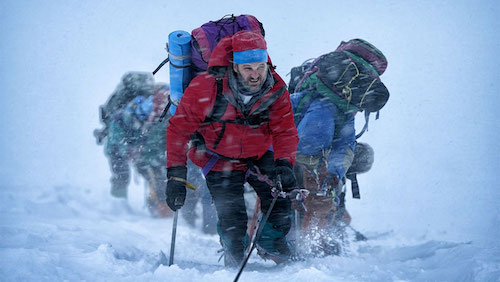
As the weather worsened, the descending team members faced increasing challenges. The blizzard on the southwest side of Everest brought poor visibility, covering the fixed ropes and erasing the trail they had created during the ascent back to Camp IV.
Rob Hall contacted the camp for assistance, reporting that Doug Hansen ‘The Mailman’ had lost consciousness but was still alive. At 17:30, Adventure Consultants guide Andy Harris set out alone from the South Summit (8,749 m) towards Hansen and Hall, carrying extra oxygen and water. According to Krakauer’s account, the weather had deteriorated into a fierce blizzard by this time, with snow pellets driven by winds of 70 mph (110 km/h) stinging his face.
During the storm, some climbers became disoriented and lost their way on the South Col. Mountain Madness guide Beidleman and clients Klev Schoening, Fox, Madsen, Pittman, and Gammelgaard, along with Adventure Consultant guide Mike Groom and clients Beck Weathers and Yasuko Namba, found themselves wandering in the blizzard. They walked until they could no longer continue, eventually huddling together about 20 meters (66 feet) away from a steep drop-off known as the Kangshung Face.
8 Climbers Died in The 1996 Mt Everest Disaster:
During the night of May 10, Doug Hansen lost his life, and the next day, Rob Hall tragically passed away on the South Summit. Hall’s guide, Andy Harris, was affected by hypoxia and also perished.
Rob Hall managed to survive for two nights on the South Summit and part of a third day before succumbing to the elements. Andy Harris and Doug Hansen’s bodies were never found, while Scott Fischer’s body was later found by Beidleman. Rob Hall’s body rested on the South Summit briefly before falling 12,000 feet to the base of the mountain.
Beck Weathers survived and later wrote a book called “Left for Dead,” (affiliate link!) recounting how he was abandoned on the mountain three times and had to save himself. His wife, Peach, organized a historic rescue mission, which involved the highest and first-ever helicopter rescue at Camp 2 to save his life.
1996 Everest Disaster Death List:
Here are the climbers who died during the 1996 disaster:
| SN | Name | Nationality | Expedition | Location of Death |
|---|---|---|---|---|
| 1 | Andrew “Harold” Harris (Guide) | New Zealand | Adventure Consultants | Close to South Summit (8,729 m) |
| 2 | Doug Hansen (Client) | United States | ||
| 3 | Rob Hall (Expedition leader/ Guide) | New Zealand | ||
| 4 | Yasuko Namba (Client) | Japan | ||
| 5 | Scott Fischer (Expedition leader/ Guide) | United States | Mountain Madness | Southeast Ridge (8,300 m) |
| 6 | Subedar Tsewang Smanla | India | Indo-Tibetan Border Police | Northeast Ridge (8,600 m) |
| 7 | Lance Naik Dorje Morup | India | ||
| 8 | Head Constable Tsewang Paljor | India |
Analysis Of The 1996 Mount Everest Disaster
Many believe that the Everest disaster was caused due to several factors:
- The leaders of the expedition didn’t realize that a strong blizzard would hit on May 11, as they didn’t fully understand the increasing snowfall on May 10.
- There was a rivalry between Rob Hall and Scott Fischer, who were both focused on getting their clients to the summit. This rivalry caused them to overlook the weather forecasts.
- The guide from the South African team was unwilling to help contact the base camp, while the radios of other teams were not strong enough.
- There were bottlenecks at the Balcony and Hillary Step, causing a delay of around one and a half hours for climbers trying to reach the summit. This delay occurred because of difficulties in securing fixed ropes and the large number of climbers arriving at these points simultaneously (34 climbers on May 10).
- The team leaders made the decision to continue climbing past the usual turnaround time of 2:00 pm, with many climbers reaching the summit after 2:30 pm.
- Two climbers fell ill unexpectedly near or at the summit after 3:00 pm.
- Severe oxygen deprivation sickness affected both climbers and guides, impairing their decision-making abilities and their capacity to help others.
- There was a shortage of oxygen supplies, which required guides and rescue teams to carry bottles to stranded climbers as the storm approached.
- According to Jon Krakauer, the use of bottled oxygen and commercial guides created a situation where inexperienced climbers could attempt to reach the summit, leading to more dangers and deaths.
- He also suggests that the competition between Rob Hall and Scott Fischer’s influenced Hall’s decision not to turn back on May 10, even though the summiting deadline was 2:00 pm.
Note: Much of the analysis comes from Jon Krakauer and Anatoli Boukreev. Both wrote books detailing the events: “Into Thin Air” and “The Climb” respectively (affiliate links!) Additionally, the Everest movie from 2015 also recounts the events of the 1996 Mount Everest disaster, and has become one of the most watch movies on Everest – although not as reliable as it was a dramatization of the events that day. History vs Hollywood has a good comparison of the Everest movie, and the actual people on Everest in 1996.
Legacy of the 1996 Everest Disaster:

The 1996 Everest Disaster had a lasting impact on mountaineering culture. It changed the way people thought about and approached climbing the world’s highest peak. The tragedy highlighted the immense risks and challenges involved in climbing Everest.
One of the major impacts is a greater emphasis on safety and preparedness. Climbers and expedition leaders became more cautious and focused on ensuring they have the necessary skills, experience, and equipment before attempting such dangerous climbs.
Another lasting effect is the reassessment of commercial expeditions. The events of 1996 raised questions about the role of commercial guiding companies and the impact of overcrowding on the mountain. It led to discussions and debates about the ethics of guided climbs and the responsibility of leaders to prioritize safety over personal or financial interests.
My Take on the 1996 Everest Disaster:
The Everest disaster is documented by multiple climbers who were present that day, including Jon Krakauer’s ‘Into Thin Air,’ Boukreev’s ‘The Climb,’ ‘After The Wind’ by survivor Lou Kasischke, and Ed Viesturs’ ‘No Shortcuts to the Top.’ These conflicting accounts make it challenging to determine the factual story, but they contribute to a more comprehensive understanding of the disaster.
Jon Krakauer and Boukreev had well-known disagreements, with Krakauer blaming Boukreev for unprofessionalism and not using oxygen. However, Boukreev conducted a remarkable search and rescue effort when others, including Krakauer, were unable to.
The responsibility for the eight climbers’ deaths cannot be placed solely on one person or the expedition leaders (Rob and Scott). It results from the commercialization of the mountain, the pressure to reach the summit, and the competitive climbing industry in the 1990s.
The presence of Jon Krakauer’s writing and Sandy Hill Pitman’s reporting added to the importance of having a successful expedition company. The competition for climbing Everest and catering to inexperienced climbers began in 1996 and continues today, leading to another deadly climbing season in 2023.
FAQs: The 1996 Mount Everest Disaster
Below are some of the most frequently asked questions regarding the 1996 Mount Everest disaster.
Eight climbers lost their lives on Mount Everest during a storm on May 10, 1996, marking the deadliest day in the mountain’s history. Author Jon Krakauer, who was attempting the ascent, later wrote the bestselling book Into Thin Air, published in 1997, recounting the gripping tale of the tragedy and its lasting impact.
The tragedy unfolded due to a combination of “Summit Fever” and the excessive commercialization of the mountain, resulting in significant delays. The core of the disaster can be attributed to a Sherpa guide’s decision, the ambitious goals of the team leader, and the negligent work ethic of the head guide.
A total of 8 climbers died on Mount Everest 1996:
1. Andrew “Harold” Harris
2. Doug Hansen
3. Rob Hall
4. Yasuko Namba
5. Scott Fischer
6. Subedar Tsewang Smanla
7. Lance Naik Dorje Morup
8. Tsewang Paljor (Green Boots)
The primary causes of fatalities during Mount Everest climbs are injuries and extreme fatigue. Additionally, a significant number of climbers succumb to high altitude-related illnesses, particularly high altitude cerebral edema (HACE) and high altitude pulmonary edema (HAPE).
